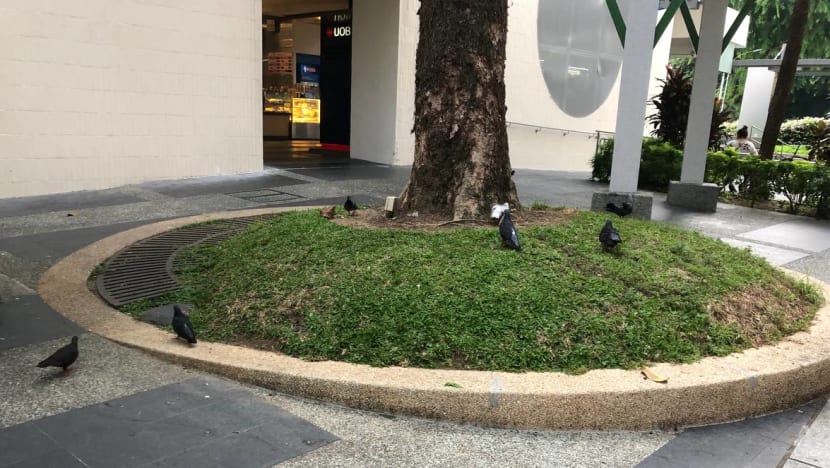Pigeon control measures: Residents mostly unfazed by birds; nature group calls for enforcement against feeding
Estates under three town councils - Ang Mo Kio, Bishan-Toa Payoh and Tanjong Pagar - will step up culling and other control measures to manage the pigeon population.

A handful of pigeons spotted near Bukit Merah Town Centre on Jun 25, 2024. (Photo: CNA/Natasha Ganesan)

This audio is generated by an AI tool.
SINGAPORE: Pigeons are aplenty but not a big issue for some residents living in estates where measures will be stepped up to manage the bird population.
Under a pilot initiative announced on Tuesday (Jun 25), Ang Mo Kio, Bishan-Toa Payoh and Tanjong Pagar town councils will be involved in culling pigeons over the next six months to remove them "humanely".
Government agencies also aim to reduce food sources for pigeons, by improving refuse and waste management at bin centres and food and beverage outlets.
Enforcement action will be taken against food establishments that do not comply and people who illegally feed the birds.

When CNA visited several HDB estates managed by the three town councils on Tuesday, some blocks had walkways stained by bird droppings.
Residents who have seen pigeons in large numbers told CNA that the birds were not an issue to them.
Ang Mo Kio resident Siti, 22, said it could be "scary" if there were too many pigeons and she would be afraid to walk near them.
But she does not find them a nuisance "as long as they do not bother (her)", said the attractions operator, who goes by one name.
Another resident, an admin executive in her 30s who wanted to be known as Ms Aw, pointed out that some seniors often feed the pigeons around Ang Mo Kio Avenue 3.
Non-profit organisation Nature Society Singapore Bird Group also said it has encountered pigeons feeding on food left by residents.
The group's vice chairman Tan Gim Cheong welcomed more policing against bird feeding, adding that there should be a publicity blitz about this.
Penalties meted out to bird feeders should also be publicised to deter others from following suit. But having the manpower to do so may be a constraint, noted Mr Tan.
CULLING "EXPECTED" WHEN THERE ARE HYGIENE ISSUES
Most hawkers CNA spoke to also said the pigeons were not a big problem. But one stall owner at Bukit Merah Central Food Centre complained that pigeons often fly onto tables occupied by customers.
Mdm Leong, who owns a yong tau foo stall, recalled one incident where a customer stepped away from her food for a short while to get more sauce and returned to find several pigeons next to her food.
But Mdm Leong, who only gave her last name, stressed that the issue lies with the lack of cleanliness and culling pigeons may not be the solution.
To this, Mr Tan from Nature Society Singapore Bird Group highlighted that culling is "expected" when pigeons start to pose environmental and hygiene issues.
"It is good to remove non-native species, such as these feral pigeons, as (they) often negatively impact the environment," he added.
At the same time, he expressed concern over secondary poisoning of other animals and birds such as the crested goshawk that may prey on pigeons that have ingested the chemicals.
He added that the targeted pigeons should be removed promptly so that predators are not inadvertently affected. The chemicals used should also be properly disposed of to avoid harming other animals, Mr Tan said.
As for Ang Mo Kio resident Ms Aw, she questioned if there may be a "better way" to deal with the problem, while also pointing out that she was not "adversely affected" by the decision.
Likewise, fellow resident Ms Siti said: "I mean to (cull) them … is a bit pity but if there are too many (pigeons), they will be bothering others."
















